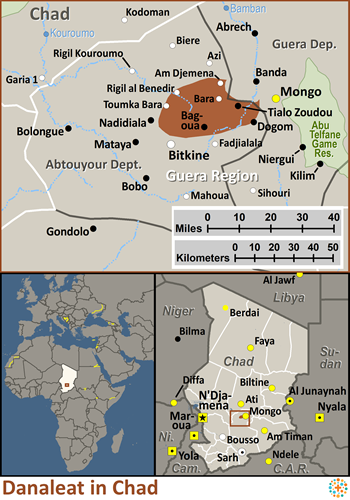The term Hadjeray, which means "of the stones or mountains," is a collective term used to describe a group of mountain peoples living in the Hadjeray region of south central Chad. They are descendants of peoples from the surrounding plains who fled to the mountains in an attempt to escape the invasions of neighboring tribes. The Hadjeray include such groups as the Kenga, the Bidio, the Jongor, and the Dangaleat. All of these groups speak Chadic languages, except the Kenga, who speak a Sara-Bongo-Baguirimi language.
Besides their geographic and linguistic closeness, the groups of the Hadjeray region have similar cultures and religions. Despite these similarities, however, most of the groups are hesitant to intermarry, preferring to maintain separate identities. Although the groups are somewhat independent of one another, their relationships remain peaceful. In fact, they have often rallied together to maintain independence from outside forces. For instance, all the Hadjeray groups played a prominent role in the 1960 rebellion against the Chadian national government. For these reasons, we must sometimes pray for each of the peoples of the Hadjeray region separately. One of these is the Dangaleat.
The Dangaleat people are primarily farmers who attempt to cultivate the rocky ground of the region. Some, however, have moved to the cities and taken jobs in construction or in the government. The main crop grown is millet; but some cotton, okra, beans, and corn are also grown, along with a variety of fruits and vegetables. Their main diet consists of a millet paste, eaten with a sauce made from wild leaves, meat, or dried fish.
Most of the Dangaleat people receive income from selling surplus millet and from transporting goods for others. They trade with the nearby Arabs on a regular basis in order to purchase items they cannot otherwise obtain. In these trades, millet is given for milk, meat, and items made by Arab blacksmiths.
The Dangaleats make only a few handicrafts, most of which are for their own use and not for sale to others. Some of the crafts include woven palm leaf mats, clay jars for transporting and storing water and grain, and cotton thread and fabric.
The Dangaleat people have a number of villages. Most villages have several clans, each of which lives in its own neighborhood. Each village is run by a chief or headman, who is primarily in charge of settling disputes between the villagers. Every village also has a "chief of the land," who holds the "religious power" of the village.
Most Dangaleats are rural and live in round, mud-brick huts with cone-shaped, thatch roofs. In town, the dwellings are also made of mud-brick, but are rectangular in shape and have flat roofs. The villages consist of several compounds. Each compound contains a number of huts belonging to an extended family.
Most Dangaleat women wear colorful print fabrics, which are either wrapped around their bodies or tailored into dresses. Head coverings are worn by the women when they are outside their own compounds. The men wear Western-style pants with shirts, or long robes with or without pants.
Although many Dangaleat villages have a primary school, the teachers are generally inadequate. Many children who attempt school soon drop out. In addition to schools, there is other evidence of modernization among the Dangaleat. Kerosene lanterns and flashlights are used in each compound, but sparingly. Short-wave radios and digital watches are not uncommon. Some Dangaleat even own bicycles or mopeds. Other modern features, such as electricity, telephones, clean water, and health care facilities, are not present.
Although a majority of the Dangaleat have completely converted to Islam, the Kenga remain only largely Muslim. Pre-Islamic beliefs, however, are still practiced by all the groups, including the Kenga. Therefore, the tribes remain united in religion. All of the groups belong to what is known as the margais cult. The margais are believed to be invisible spirits who live in nature's formations and control the natural elements.
All tribes in this region need more educational opportunities and quality health care facilities. Perhaps Christian teachers and medical workers will have the greatest opportunities to share the love of Jesus with them.
The Dangaleat tribe is also in need of Christian resources in their own language. A very few people of the Hadjeray region have accepted Jesus as their Savior. In fact, most of them have never yet had an opportunity to hear a clear presentation of the gospel.
Increased mission efforts, additional laborers, Christian broadcasts, and evangelistic literature are greatly needed to effectively reach the Dangaleat tribe with the gospel.
Pray for abundant rain and an excellent harvest as a testimony of God's provisions.
Pray that God will call Christian teachers and medical workers to minister to the Dangaleat people of the Hadjeray region.
Ask the Lord to raise up strong local fellowships of believers among the Dangaleat people.
Ask God to raise up long term missionaries to join the few who are serving in Chad.
Pray that signs and wonders will come to the Dangaleat tribe, showing them that God is all powerful and all loving.
Ask God to raise up prayer teams who will begin breaking up the spiritual soil of Chad through intercession.
Scripture Prayers for the Dangaleat in Chad.
https://en.wikipedia.org/wiki/Hadjarai_peoples
https://voice.dts.edu/article/faith-that-goes-the-distance-dallas-theological-seminary/
| Profile Source: Joshua Project |

























